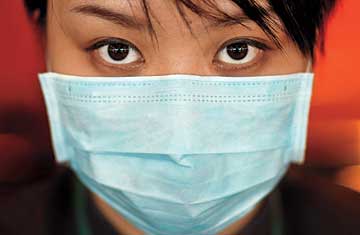
Where H1N1 spread, masks followed in an effort to stem the new flu virus.
(3 of 4)
The occasional pathogen will get through even the most vigilant early-warning system. Viruses, after all, are pretty good at what they do. A new flu pandemic is all but inevitable, and while the response to H1N1--the rapid deployment of Tamiflu, the blizzard of advice from the Federal Government--shows we're better prepared for a pandemic than ever before, it doesn't mean we're truly prepared. A virulent flu pandemic--one that spreads throughout the world and sickens 25% to 30% of Americans--would cause our health-care system to crash like an overloaded website. Partly because of recession-fueled budget cuts that have led to the loss of 10,000 jobs in state and local health agencies over the past year, our hospitals have little in the way of surge capacity--excess beds and ventilators--that would allow them to handle a sudden influx of sick patients. And there's no guarantee that those hospitals could remain staffed during the peak of a pandemic. "We haven't tested what would happen if one-third of the public-health workforce were not available because they were sick or taking care of family members," says Robert Pestronk, executive director of the National Association of County and City Health Officials.
The disruption that a pandemic might cause outside the health sector--what Michael Osterholm, who heads the Center for Infectious Disease Research and Policy (CIDRAP), terms "collateral damage"--could be even worse. The "just in time" supply chain on which so many U.S. corporations rely leaves little slack and could buckle during a pandemic. In a report last year, CIDRAP noted that 40% of the U.S. coal supply, which generates half the nation's electricity, is shuttled from mines in Wyoming to the rest of the country by train. If a pandemic simultaneously sickened enough coal workers--or the tiny number of engineers qualified to operate those trains--supplies of coal could dwindle fast, switching off the lights in much of the country. "We'd be dealing with two calamities if a pandemic hit," says Osterholm. "The human morbidity from the flu and the collateral damage for the just-in-time economy."
Research by the London School of Hygiene and Tropical Medicine indicates that countries in the developing world are totally unprepared for a pandemic. That's especially true in Africa, where many nations lack pandemic plans altogether, even though high rates of HIV infection there would probably worsen the toll of flu. But there are international models the U.S. can follow. Hong Kong was ravaged by SARS in 2003, but today the city has 20 million courses of Tamiflu--three times its population. (The U.S. Federal Government has enough for just one-sixth of the population, with additional stockpiles held by states.) Holiday camps on the fringes of Hong Kong have been set up to serve as isolation wards, and the city has invested in epidemiology labs and more hospital beds. "Hong Kong really is the international gold standard when it comes to dealing with infectious disease," says Peter Cordingley, spokesman for the WHO's Western Pacific regional office.
